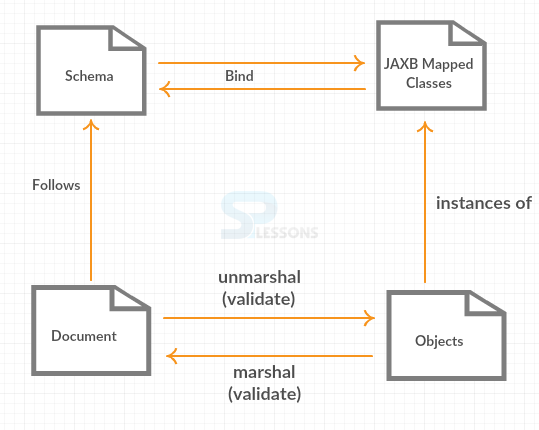 Description
Description
XML has two primary points of interest, to begin with, it offers a standard method for organizing information, and, second, the developer can determine the vocabulary the information uses.The designer can characterize the vocabulary utilizing either DTD or the XML Schema dialect.
DTDs were acquired from XML's sources as SGML (Standard Generalized Markup Language) and, accordingly, are constrained in their expressiveness. DTDs are for communicating a content report's structure, so all elements are thought to be content. The XML Schema dialect all the more nearly takes after the way a database depicts information.
Schemas give the capacity to characterize a component's sort and much better limitations. DTDs uphold a strict requesting of components; constructions have a more adaptable scope of alternatives. At long last schema's are composed in XML, while DTDs have their own particular syntax.
 Conceptual
Figure
Conceptual
Figure
The
JAXB remains for Java design for XML binding and is utilized to change over XML to java protest and java question XML.JAXB characterizes an API for perusing and composing Java items to and from XML documents. Unlike SAX and DOM, one need not to know about XML parsing methods.
The marshaling alludes to the way toward changing over the information or the items into a byte-stream, and unmarshalling is the turn around procedure of changing over the byte-stream beack to their unique information or question. The change is accomplished through "serialization".
 Example
Example
The following is an example for the XML schema.
[xml]<?xml version="1.0" encoding="UTF-8"?>
<xs:schema xmlns:xs="http://www.w3.org/2001/XMLSchema">
<xs:element name="contact">
<xs:complexType>
<xs:sequence>
<xs:element name="name" type="xs:string" />
<xs:element name="company" type="xs:string" />
<xs:element name="phone" type="xs:int" />
</xs:sequence>
</xs:complexType>
</xs:element>
</xs:schema>[/xml]
XML Schemas is utilized to portray the true blue arrangement that an XML report can take. Factors are the building squares of xml file. A aspect can be characterized inside an xsd as follows.
[xml]<xs:element name="x" type="y"/>[/xml]
These elements can be defined as a simple type and complex type. Following is the code for the simple type.
[xml]<xs:element name="phone_number" type="xs:int" />[/xml]
Easy kind element is utilized simply as a part of the setting of the content. Some of the predefined honest types are xs:integer, xs:boolean. Following is the code complex type factors.
[xml]<xs:element name="Address">
<xs:complexType>
<xs:sequence>
<xs:element name="name" type="xs:string" />
<xs:element name="company" type="xs:string" />
<xs:element name="phone" type="xs:int" />
</xs:sequence>
</xs:complexType>
</xs:element> [/xml]
A complicated type kind is a holder for other issue definitions. This allows the developer to decide which infant additives a factor can include and to provide a few shape inside the xml documents.
Where, Address component comprises of child components. This is a compartment for other definitions, that permits to fabricate a straightforward chain of command of components in the XML record.
By utilizing global type, the engineer can characterize a single sort in your archive, which can be utilized by every other reference. For instance, assume developer need to sum up the person and company for various locations of the organization. In such case, follow the code as follows.
[xml]<xs:element name="AddressType">
<xs:complexType>
<xs:sequence>
<xs:element name="name" type="xs:string" />
<xs:element name="company" type="xs:string" />
</xs:sequence>
</xs:complexType>
</xs:element> [/xml]
Now include this type in an example.
[xml]<xs:element name="Address1">
<xs:complexType>
<xs:sequence>
<xs:element name="address" type="AddressType" />
<xs:element name="phone1" type="xs:int" />
</xs:sequence>
</xs:complexType>
</xs:element>
<xs:element name="Address2">
<xs:complexType>
<xs:sequence>
<xs:element name="address" type="AddressType" />
<xs:element name="phone2" type="xs:int" />
</xs:sequence>
</xs:complexType>
</xs:element> [/xml]
 Key Points
Key Points
- Attributes in XSD will give more data within an element.
- XSD stands for XML schema definition.
- By using global type, the developer can define a single type in the document




